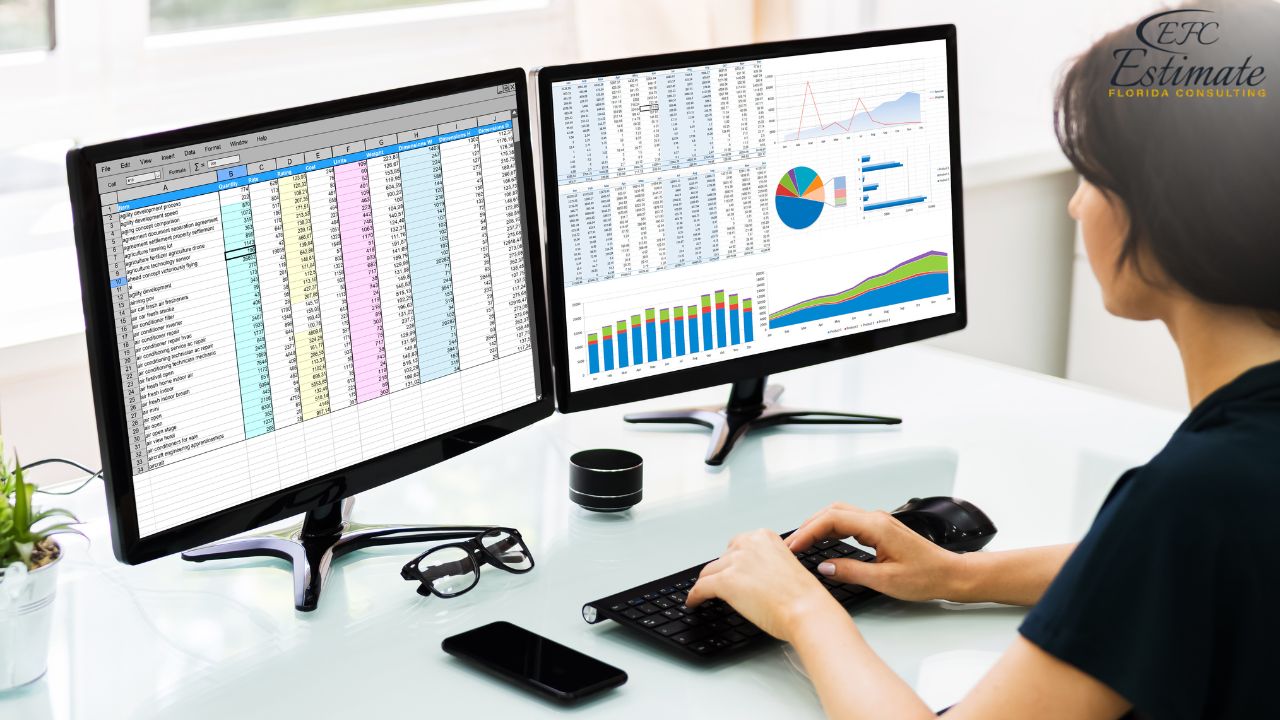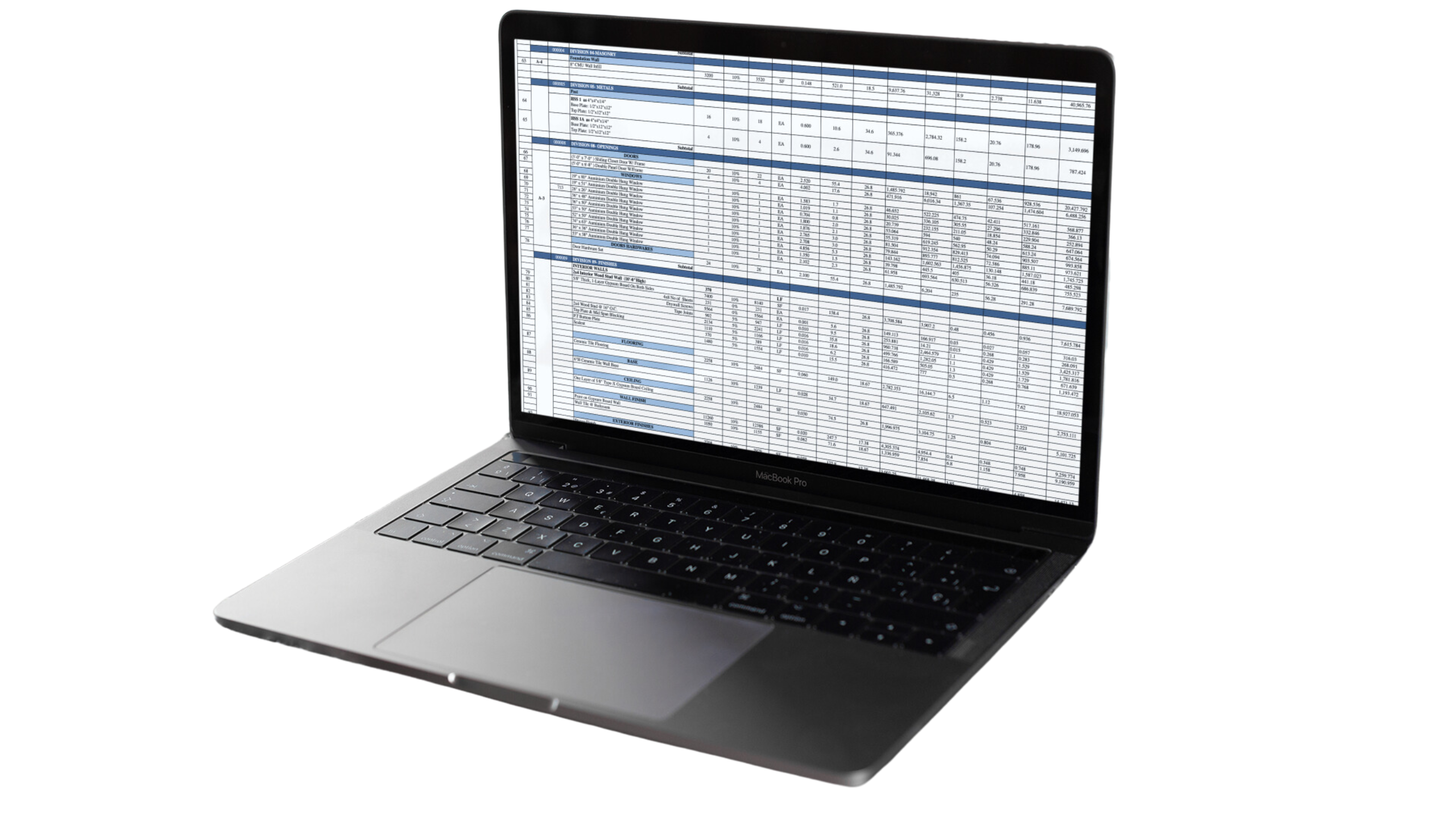- Homepage
- Blogs
Quantity Estimation for Building Using Excel
Leading provider of building estimating.
Estimating the quantities for a building project is one of the most important steps in construction. It helps contractors, builders, and developers figure out the exact materials, costs, and resources needed to complete a project successfully. Microsoft Excel is a great tool to use for this process because it’s simple, flexible, and widely available. At Estimate Florida Consulting, we make quantity estimation easier and more accurate, so you can focus on getting your project done.

What is Quantity Estimation?
Quantity estimation is the process of figuring out how much of each material, resource, and labor you’ll need for a construction project. This includes:
- Materials like cement, steel, bricks, and wood.
- Labor time and costs to complete specific tasks.
- Equipment like cranes, mixers, or scaffolding for construction work.
By estimating quantities accurately, you can:
- Control costs and avoid unnecessary expenses.
- Prevent project delays caused by shortages.
- Ensure proper allocation of resources for smooth progress.
Without proper quantity estimation, projects can face inefficiencies, waste, and budget overruns, which ultimately lead to client dissatisfaction and loss of profits.
Why Use Excel for Quantity Estimation?
Excel is a popular choice for quantity estimation because it’s:
- Easy to Use: Excel has an intuitive interface that allows users to create and manage spreadsheets without technical expertise.
- Highly Customizable: You can design templates and add formulas tailored to your project needs.
- Efficient for Calculations: Automated formulas and functions eliminate the need for manual calculations, reducing errors.
- Cost-Effective: Excel is readily available and far cheaper than specialized estimation software.
- Universal Compatibility: Most professionals use Excel, making it easy to share files with clients, architects, or team members.
Steps to Create a Quantity Estimation Sheet in Excel
Here’s how you can set up a quantity estimation sheet in Excel step-by-step:
- Outline the Project Requirements: Create a detailed list of all materials, tasks, and resources needed for your project. Include specifics such as dimensions, quantities, and units.
- Design the Spreadsheet Layout: Create clear headings such as Item Description, Quantity, Unit, Unit Price, Total Cost, and Remarks.
- Input Data Accurately: Add details for each material, such as the type of material, the amount required, and the cost per unit. Ensure all data is correct to avoid miscalculations.
- Use Formulas for Automation: Use Excel formulas to calculate totals. For example, =B2*C2 can calculate the cost for each item by multiplying quantity and unit price.
- Include Summary Sections: Add a row or table that calculates the grand total using =SUM. This ensures you have an overview of the project cost.
- Format the Sheet for Readability: Use cell borders, colors, and bold text to highlight important areas such as totals or critical materials.
- Test the Sheet for Errors: Double-check calculations and ensure all formulas are functioning as intended.
Get Acquainted with Estimation
Top 5 Cost-Effective Tips to Manage Construction Budgets!!
Glass Building Construction Cost Estimator | Call: 561.530.2845
Key Parts of a Quantity Estimation Sheet
1. Material Breakdown
A material breakdown is essential for tracking quantities and costs for each material. This includes:
- Material Types: Cement, steel, tiles, wood, etc.
- Quantities Needed: Determine based on blueprints or structural drawings.
- Units of Measurement: Specify whether items are measured in cubic meters, kilograms, or pieces.
- Unit Prices: Research current market rates to ensure realistic budgeting.
2. Labor Requirements
Labor estimation includes calculating the number of workers, hours, and wages required for each task. Consider:
- Foundation digging and pouring.
- Bricklaying and plastering.
- Plumbing, electrical wiring, and HVAC installation.
Labor costs can vary significantly depending on the complexity and region of the project.
3. Cost Analysis
A detailed cost analysis includes breaking down:
- Material Costs: The total expenditure on materials based on quantity and unit price.
- Labor Costs: Total wages calculated based on labor hours and rates.
- Equipment Costs: Charges for machinery such as cranes, mixers, and loaders.

4. Waste Management
Add a column for waste to account for material loss during construction. Typical waste allowances:
- Cement: 3-5%
- Bricks: 5-10%
- Tiles: 7-10% Adding waste management ensures you order enough materials to avoid shortages.
Benefits of Using Excel for Quantity Estimation
1. Improved Accuracy
Excel formulas help minimize manual calculation errors, ensuring reliable estimates for materials and costs.
2. Saves Time
Templates and automated calculations reduce the time spent on creating estimates from scratch.
3. Real-Time Updates
Changes in material prices or quantities can be quickly updated, giving you the most accurate estimate at any time.
Build your dream project with ease—contact Estimate Florida Consulting today!
4. Visual Tools
Charts, graphs, and pivot tables provide an easy way to visualize costs and identify areas where expenses can be optimized.
5. Scalability
Whether you’re working on a small home project or a large commercial development, Excel adapts to projects of all sizes.
Tips for Accurate Estimations in Excel
- Verify Inputs: Always double-check your data for typos or incorrect entries.
- Use Drop-Down Menus: Simplify data entry by providing predefined options for units, materials, or task descriptions.
- Protect Important Data: Lock cells containing formulas or critical values to prevent accidental edits.
- Review Regularly: Schedule periodic reviews of your estimation sheet to ensure it aligns with actual project progress and costs.
- Back Up Your Data: Save copies of your sheet to avoid losing valuable information.
Common Mistakes to Avoid in Excel Estimations
- Overlooking Waste: Forgetting to add waste factors can lead to material shortages and delays.
- Using Outdated Prices: Always use current market rates to avoid budgeting errors.
- Ignoring Hidden Costs: Account for indirect costs like transportation, storage, and taxes.
- Complicated Formulas: Overly complex formulas can lead to errors and make the sheet harder to use.
Industry Applications of Excel in Quantity Estimation
- Residential Construction: Managing costs for homes, including foundations, walls, and interiors.
- Commercial Projects: Tracking expenses for offices, retail spaces, and warehouses.
- Infrastructure Projects: Estimating for roads, bridges, and utility installations.
- Renovations and Remodeling: Planning costs for updates to existing structures.
How Estimate Florida Consulting Can Help?
At Estimate Florida Consulting, we bring years of expertise to help you with:
- Custom Excel templates for your specific projects.
- Training on how to use Excel for accurate estimations.
- Full-service estimating, including material take-offs and cost breakdowns.
- Advice on improving your efficiency and precision in the estimation process.
Download Template For Construction Project Breakdown
- Materials list updated to the zip code
- Fast delivery
- Data base of general contractors and sub-contractors
- Local estimators

Final Thoughts
Using Excel for quantity estimation is a practical and effective solution for construction professionals. Its ease of use, flexibility, and powerful features make it an essential tool for projects of all sizes. By following a clear process and using advanced Excel tools, you can manage your project costs with confidence. For expert guidance and support, reach out to Estimate Florida Consulting today and take the guesswork out of your next project!
Frequently Asked Question
To calculate quantity in Excel, you can use formulas to multiply measurements. For example, if you’re calculating the area of a room, enter the length in one cell and the width in another, then use the formula =A1*B1 to find the total. You can also sum up multiple quantities using the =SUM(range) formula. For construction estimates, organize your data in a table for clear calculations.
To calculate an estimate in Excel, list all the materials, labor, and costs in columns. Use formulas to calculate totals for each category. For example, you can multiply quantity by unit price using =Quantity*Unit_Price and sum up all costs with =SUM(range). This method gives you a clear breakdown of your total project cost.
To estimate a building's cost, break down the project into parts like foundation, walls, roofing, and finishes. Create a table in Excel with rows for each component and columns for quantities, unit costs, and total costs. Use formulas to calculate each component's cost, and sum them up for the total estimate. Templates can simplify this process.
Excel is a powerful tool in construction for creating budgets, tracking expenses, scheduling tasks, and calculating estimates. You can use it to organize data, apply formulas, and generate reports. It’s particularly useful for creating Gantt charts, tracking project progress, and managing material inventories.
A building formula in Excel refers to the mathematical calculations used for construction tasks, like finding areas, volumes, or costs. For example:
- Area: =Length*Width
- Volume: =Length*Width*Height
- Cost: =Quantity*Unit_Price These formulas help streamline construction planning and estimation.
To create a construction program in Excel, start by listing all tasks and their durations in a table. Add columns for start and end dates. Use formulas to calculate deadlines and dependencies. For a visual timeline, you can format this data into a Gantt chart using Excel's conditional formatting or chart tools.
To make a Gantt chart in Excel:
- List all tasks, start dates, and durations in a table.
- Create a timeline with dates across the top.
- Use conditional formatting to fill cells corresponding to the task duration.
- Alternatively, use Excel's bar chart feature to create a professional-looking Gantt chart.
The formula builder in Excel is a tool that helps you create and edit formulas easily. It provides suggestions and explanations for functions as you type, making it easier to construct complex calculations. It’s a handy feature for anyone working with large datasets or intricate estimations.
Comprehensive Trade-Specific Estimates
At Estimate Florida Consulting, we offer detailed cost estimates across all major trades, ensuring no part of your project is overlooked. From the foundation to the finishing touches, our trade-specific estimates provide you with a complete and accurate breakdown of costs for any type of construction project.

Testimonials
What Our Clients Say
We take pride in delivering accurate, timely, and reliable estimates that help contractors and builders win more projects. Our clients consistently praise our attention to detail, fast turnaround times, and the positive impact our estimates have on their businesses.
Estimate Florida Consulting has helped us win more bids with their fast and accurate estimates. We trust them for every project!

Steps to Follow
Our Simple Process to Get Your Estimate
01
Upload Plans
Submit your project plans, blueprints, or relevant documents through our online form or via email.
02
Receive Quotation
We’ll review your project details and send you a quote based on your scope and requirements.
03
Confirmation
Confirm the details and finalize any adjustments to ensure the estimate meets your project needs.
04
Get Estimate
Receive your detailed, trade-specific estimate within 1-2 business days, ready for your project execution.
















